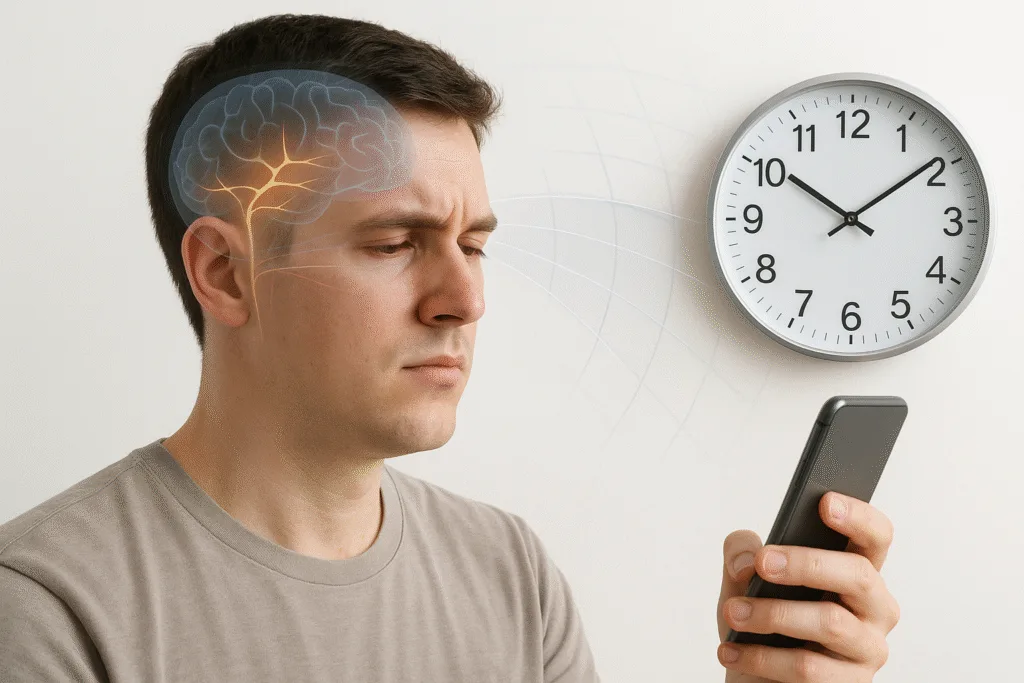The scrolling vision strain test reveals what happens to your eyes when you scroll continuously for just two minutes. Although scrolling is part of daily life, most people do not realize how quickly it fatigues the visual system. This test demonstrates how scrolling affects focus, blink rate, tear stability and eye muscles — all within moments.
Your eyes were not designed for constant vertical movement on bright screens. When you perform the scrolling vision strain test, you can observe the early signs of digital strain long before discomfort becomes noticeable.
Let’s begin.
Step 1 — Sit Comfortably at a Normal Viewing Distance
Position your phone or screen around 30–40 cm from your eyes.
Sit upright with a neutral posture.
Why this matters
A neutral starting point allows you to clearly observe visual changes during the scrolling vision strain test.
Step 2 — Look at a Still Object for 5 Seconds
Choose a stationary object such as:
- a book
- a wall
- a pen
- a distant spot
Focus on it for 5 seconds.
Why
This establishes your baseline focus and eye comfort before scrolling begins.
Step 3 — Begin Scrolling Continuously for 2 Minutes
Scroll your feed:
- TikTok
- X
- news articles
- messages
- photo gallery
But do not stop scrolling.
What’s happening
Your eye muscles start working harder to constantly refocus at varying depths and movement speeds.
Step 4 — Pay Attention to Your Blink Rate
After about 20–25 seconds, you will blink less frequently.
This is automatic.
Why it happens
Scrolling narrows visual attention, reducing blink rate.
Lower blinking dries the surface of the eye and destabilizes tear film.
This is a core part of the scrolling vision strain test.

Step 5 — Notice Any Subtle Vision Fatigue
As you continue scrolling, observe:
- slight heaviness in the eyes
- mild blur
- reduced visual sharpness
- increased effort to focus
Why
Constant screen motion forces the ciliary muscles to work continuously with minimal rest.
Step 6 — Stop Scrolling and Look at the Object From Step 2
Now stop immediately.
Look back at the same stationary object.
What you’ll notice
For the first one or two seconds:
- the object may appear slightly blurry
- focus may lag
- your eyes may feel dry
- colors may appear duller
This demonstrates the focus lag triggered by scrolling.
Step 7 — Blink Rapidly for 5 Seconds
Blink intentionally and rapidly for 5 seconds.
Why
Blinking rehydrates the cornea, resets focus and relaxes the external eye muscles.
This helps identify how the scrolling vision strain test affected your tear stability.
Step 8 — Compare Your Comfort Level Before and After
Think back to Step 1.
Compare:
- clarity
- comfort
- moisture
- effort to focus
- awareness of your eyes
Result
Even two minutes of scrolling can noticeably increase strain or dryness.
This reveals how sensitive your visual system is to repetitive digital motion.
Step 9 — Try the Brightness Variation
Increase screen brightness to maximum.
Repeat the test for 60 seconds.
What changes
High brightness intensifies:
- glare
- squinting
- ciliary muscle fatigue
- eye dryness
This variation shows how display brightness influences the scrolling vision strain test.
Step 10 — What This Everyday Habit Reveals About You
The scrolling vision strain test demonstrates key insights about how your eyes respond to screens:
1. Blink rate decreases during scrolling
This increases dryness and irritation.
2. Focus lag appears even after short exposure
Your eye muscles need recovery time.
3. Tear film becomes unstable
This affects clarity and comfort.
4. Attention narrowing intensifies strain
Scrolling creates a tunnel-like visual pattern.
5. Vertical motion is more demanding
Your visual system was not built for constant vertical tracking.
6. Brightness amplifies visual fatigue
Overexposure accelerates strain.
7. Scrolling is not passive
It requires constant micro-adjustments from multiple eye muscles.
The scrolling vision strain test confirms that even brief scrolling sessions impact your vision more than you realize.
Next Everyday Experiment You Should Try
If the scrolling vision strain test revealed how scrolling affects your eyes, the next everyday experiment shows how sound notifications trigger automatic body reactions before you even pick up your phone.
Recommended next article:
“The Notification Reflex Test — How Your Body Reacts Before You Touch the Screen”
